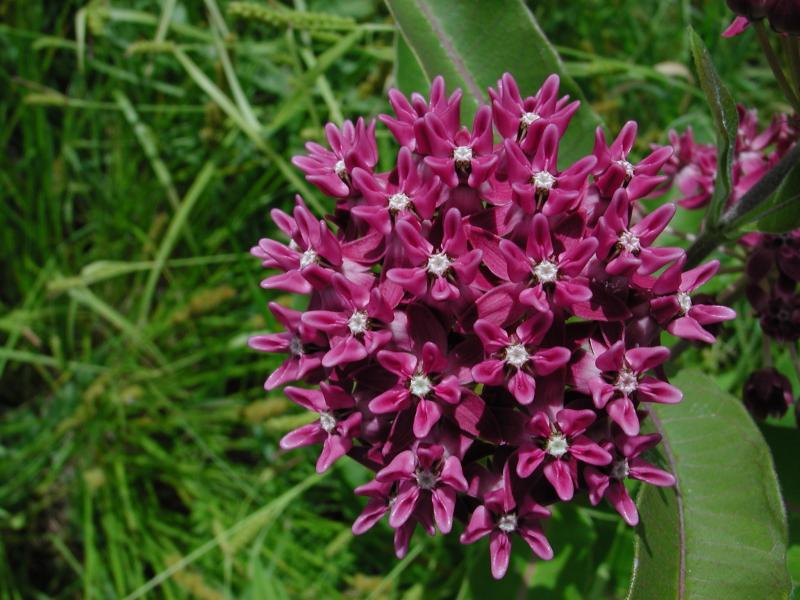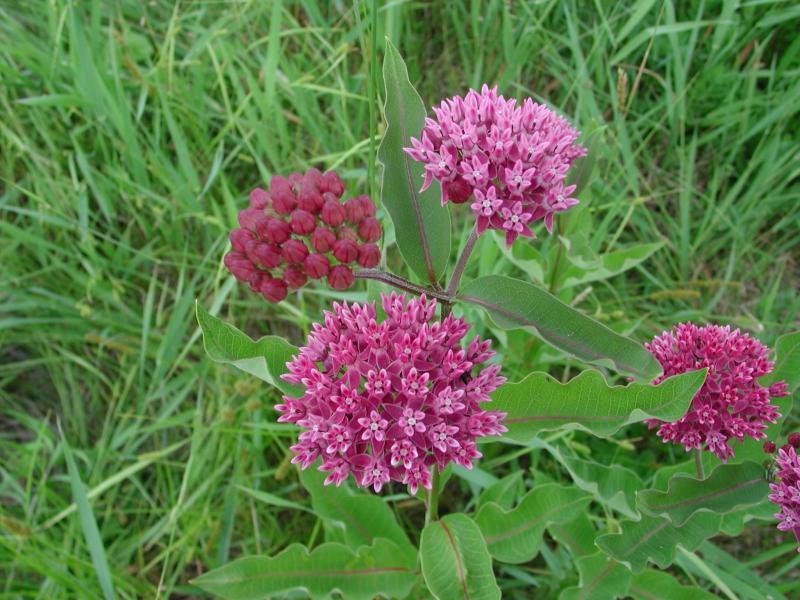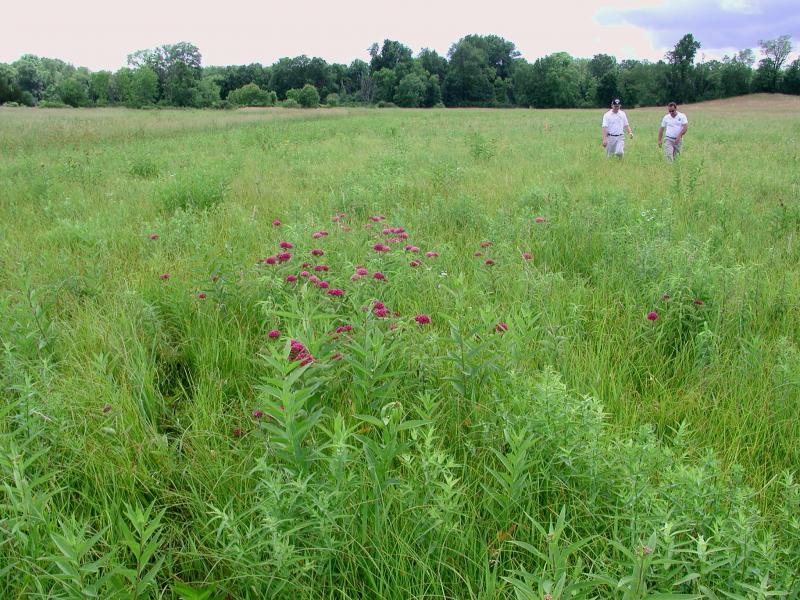Purple Milkweed
Asclepias purpurascens L.
- Class
- Dicotyledoneae (Dicots)
- Family
- Apocynaceae (Dogbane Family)
- State Protection
- Threatened
Listed as Threatened by New York State: likely to become Endangered in the foreseeable future. For animals, taking, importation, transportation, or possession is prohibited, except under license or permit. For plants, removal or damage without the consent of the landowner is prohibited.
- Federal Protection
- Not Listed
- State Conservation Status Rank
- S2S3
Imperiled or Vulnerable in New York - Very vulnerable, or vulnerable, to disappearing from New York, due to rarity or other factors; typically 6 to 80 populations or locations in New York, few individuals, restricted range, few remaining acres (or miles of stream), and/or recent and widespread declines. More information is needed to assign either S2 or S3.
- Global Conservation Status Rank
- G4G5
Apparently or Demonstrably Secure globally - Uncommon to common in the world, but not rare; usually widespread, but may be rare in some parts of its range; possibly some cause for long-term concern due to declines or other factors. More information is needed to assign either G4 or G5.
Summary
Did you know?
Purple milkweed almost always occurs in small populations with fewer than one hundred plants. New York has the largest population in the nation with over 1000 plants.
State Ranking Justification
There are ten existing populations and 22 historical occurrences. The populations at all but one site are fewer than 30 plants. The New York sites are in areas that are being developed rapidly and have come under threat by invasive species.
Short-term Trends
Most populations are below 30 plants and grow in areas that are susceptible to succession and invasive species. Most of the populations occur in the Lower Hudson region which is developing rapidly. These factors probably forecast a short-term decline. Fortunately a large population was recently found in Orange County and there is hope that more populations can be found in the area.
Long-term Trends
The long-term trend has been declining in the last 100 years as areas in the Lower Hudson region and Long Island have been developed. There were 22 historical locations but many of these have been extirpated by development.
Conservation and Management
Threats
Purple milkweed populations are threatened by loss of habitat by development and succession, especially by exotic invasive species.
Conservation Strategies and Management Practices
The hydrologic regime and the open habitat need to be maintained while controlling invasive species.
Research Needs
Research is needed to find out why most populations are fewer than 30 plants and if habitat requirements include soil that is wet in the spring and dry in the summer. A professor at SUNY Cortland is studying the genetic relationships among populations.
Habitat
Habitat
Although elsewhere purple milkweed has been characterized as a species of dry habitats, in New York it has been found in a wide diversity of open habitats, from sedge meadows, wet fields, and fens, to dry oak woods, serpentine barrens, and hay meadows (New York Natural Heritage Program 2007, Voss 1996, Gleason and Cronquist 1991).
Associated Ecological Communities
- Hempstead Plains grassland*
(guide)
A tall grassland community that occurs on rolling outwash plains in west-central Long Island. This community occurs inland, beyond the influence of offshore winds and salt spray.
- Pastureland*
Agricultural land permanently maintained (or recently abandoned) as a pasture area for livestock.
- Red cedar rocky summit*
(guide)
A community that occurs on warm, dry, rocky ridgetops and summits where the bedrock is calcareous (such as limestone or dolomite, but also marble, amphibolite, and calcsilicate rock), and the soils are more or less calcareous. The vegetation may be sparse or patchy, with numerous lichen covered rock outcrops.
- Rich graminoid fen
(guide)
A wetland of mostly grasses usually fed by water from highly calcareous springs or seepage. These waters have high concentrations of minerals and high pH values, generally from 6.0 to 7.8. Plant remains do not decompose rapidly and these grasses usually grow on older, undecomposed plant parts.
- Sedge meadow
(guide)
A wet meadow community that has organic soils (muck or fibrous peat). Soils are permanently saturated and seasonally flooded. The dominant herbs must be members of the sedge family, typically of the genus Carex.
- Serpentine barrens
(guide)
A grass-savanna community that occurs on shallow soils over outcrops of serpentine bedrock. In New York this community is known only from Staten Island, where the remnants are relatively disturbed.
* probable association but not confirmed.
Associated Species
- Asclepias syriaca (common milkweed)
- Desmodium glutinosum
- dicanthelium clandestinum
- Erigeron annuus (annual daisy fleabane)
- Lythrum salicaria (purple loosestrife)
- Myrica pensylvanica
- Panicum virgatum (switch grass)
- Phalaris arundinacea (reed canary grass)
- Quercus rubra (northern red oak)
- Rhus copallinum
- Rudbeckia hirta (common black-eyed Susan)
- Sassafras albidum (sassafras)
- Scirpus atrovirens (dark-green bulrush)
- Solidago caesia
- Solidago rugosa
- Thalictrum pubescens (tall meadow-rue)
Range
New York State Distribution
In New York purple milkweed is known primarily from theLong Island and New York City areas, extending up the lower Hudson Valley as far north as Greene County.
Global Distribution
This species occurs from Maine to southern Ontario in the north and ranges as far south as Georgia and west to Texas.
Identification Comments
General Description
Purple milkweed is a stout-stemmed, opposite-leaved, perennial herb, growing up to 1 meter tall. Like those of most milkweed species, its leaves and stems bleed its namesake sticky, whitish sap when cut. Its striking purplish-red flowers have the strongly reflexed "upside-down" looking corolla typical of the genus, and are about 1.25 cm long and bright purplish red. Its leaves have dense white pubescence on their undersides.
Best Life Stage for Proper Identification
Asclepias purpurascens is best identified when in flower.
Similar Species
Purple milkweed is most similar to common milkweed (Asclepias syriaca) and swamp milkweed (Asclepias incarnata). It may grow together with either or both of these species in New York. Its purplish-red flowers are much brighter than the whitish pink or purple flowers of common milkweed, and it has glabrous corollas, while the corollas of common milkweed are pubescent on the outside.
Purple milkweed's flowers differ from the flowers of swamp milkweed in having short, inconspicuous horns, in contrast to swamp milkweed's horns which are longer than its hoods (New York Natural Heritage Program 2007, Rhoads and Block 2000, Voss 1996).
With some effort purple milkweed may be identified in vegetative form as well. Purple milkweed's leaves have veins running nearly perpendicular from the midveins, while those of swamp milkweed form a strongly acute angle with the midrib, and purple milkweed's leaves also have net-venation more evident, in contrast to the strongly pinnate veination of common milkweed, though the two species can be difficult to distinguish, and in fact may hybridize (Voss 1996, Newcomb 1977).
Best Time to See
The best time to survey for purple milkweed is when it is in bloom, in late June or early July, as its striking flowers are difficult to overlook.
- Flowering
- Fruiting
The time of year you would expect to find Purple Milkweed flowering and fruiting in New York.
Purple Milkweed Images
Taxonomy
Purple Milkweed
Asclepias purpurascens L.
- Kingdom Plantae
- Phylum Anthophyta
- Class Dicotyledoneae
(Dicots)
- Order Gentianales
- Family Apocynaceae (Dogbane Family)
- Order Gentianales
- Class Dicotyledoneae
(Dicots)
- Phylum Anthophyta
Additional Resources
Best Identification Reference
Gleason, Henry A. and A. Cronquist. 1991. Manual of Vascular Plants of Northeastern United States and Adjacent Canada. The New York Botanical Garden, Bronx, New York. 910 pp.
Other References
Clemants, Steven and Carol Gracie. 2006. Wildflowers in the Field and Forest. A Field Guide to the Northeastern United States. Oxford University Press, New York, NY. 445 pp.
Fernald, M.L. 1950. Gray's manual of botany. 8th edition. D. Van Nostrand, New York. 1632 pp.
Holmgren, Noel. 1998. The Illustrated Companion to Gleason and Cronquist's Manual. Illustrations of the Vascular Plants of Northeastern United States and Adjacent Canada. The New York Botanical Garden, Bronx, New York.
New York Natural Heritage Program. 2010. Biotics database. New York Natural Heritage Program. New York State Department of Environmental Conservation. Albany, NY.
New York Natural Heritage Program. 2024. New York Natural Heritage Program Databases. Albany, NY.
Newcomb, Lawrence. 1977. Newcomb's Wildflower Guide: An Ingenious New Key System for Quick, Positive Field Identification of the Wildflowers, Flowering Shrubs, and Vines of Northeastern and North-Central North America. Little, Brown and Company. Boston.
Rhoads, Ann F. and Timothy A. Block. 2000. The Plants of Pennsylvania, an Illustrated Manual. University of Pennsylvania Press, Philadelphia, PA.
Voss, Edward G. 1996. Michigan Flora Part III. Dicots Concluded (Pyrolaceae - Compositae). Cranbrook Institute of Science Bulletin 61 and University of Michigan Herbarium. 622 pp.
Weldy, T. and D. Werier. 2010. New York flora atlas. [S.M. Landry, K.N. Campbell, and L.D. Mabe (original application development), Florida Center for Community Design and Research http://www.fccdr.usf.edu/. University of South Florida http://www.usf.edu/]. New York Flora Association http://newyork.plantatlas.usf.edu/, Albany, New York
Weldy, Troy W. and David Werier. 2005. New York Flora Atlas. [S.M. Landry, K.N. Campbell, and L.D. Mabe (original application development), Florida Center for Community Design and Research. University of South Florida]. New York Flora Association, Albany, NY. Available on the web at (http://newyork.plantatlas.usf.edu/).
Links
About This Guide
Information for this guide was last updated on: January 18, 2008
Please cite this page as:
New York Natural Heritage Program. 2024.
Online Conservation Guide for
Asclepias purpurascens.
Available from: https://guides.nynhp.org/purple-milkweed/.
Accessed July 27, 2024.


